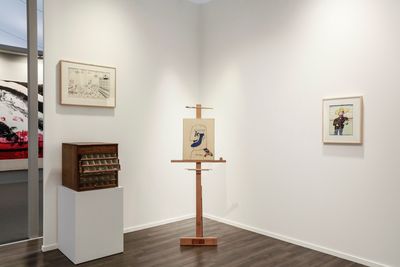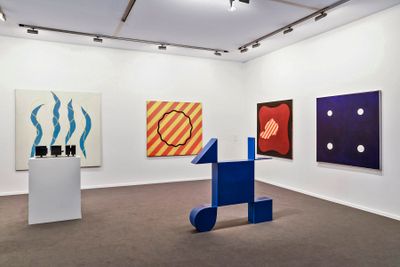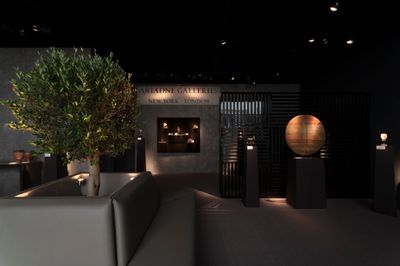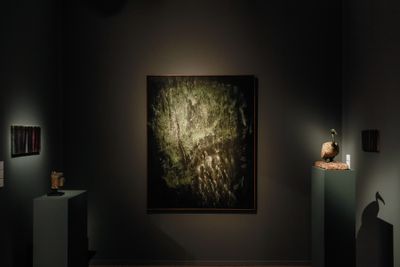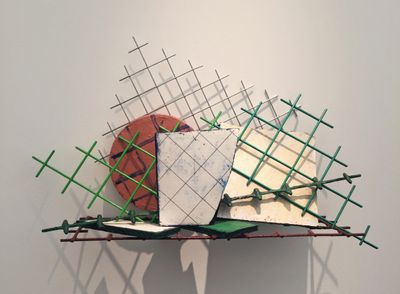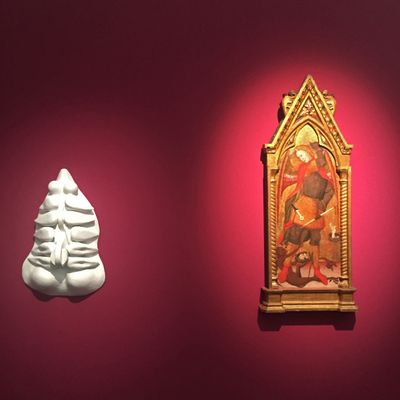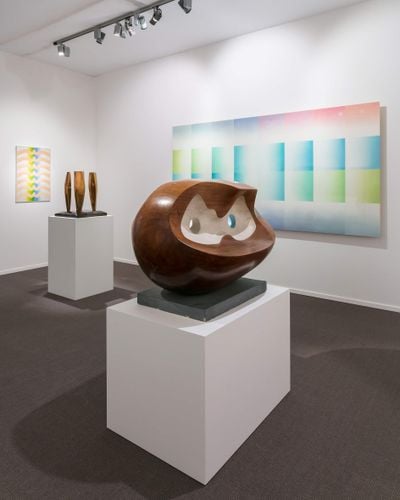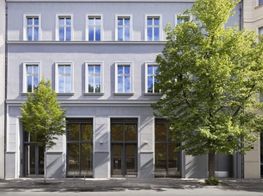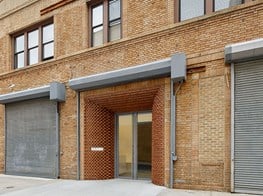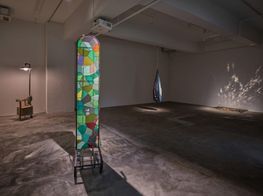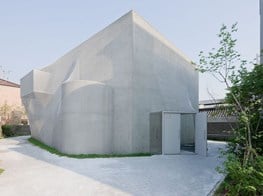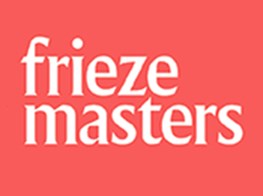Close Encounters: Frieze Masters 2017
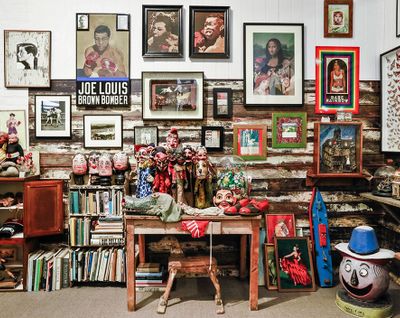
Installation view: At Work with Peter Blake, Waddington Custot, Frieze Masters, London (5–8 October 2017). Courtesy Ocula. Photo: Charles Roussel.
Throughout the fair, the best presentations sought to expand, redefine, or offer new ways of entering into the canon, rather than re-enforcing it.
There was a palpable buzz at the sixth edition of Frieze Masters. An excitement whipped up by the exhilarating way ancient and modern were brought together by galleries offering intriguing blends of artefact and artwork. This is a fair that makes history feel accessible. It was remarkable to see the Alaskan Kodiak Madonna (dating to 500–200 BCE), in such close proximity to Brancusi's black and white photograph of a similar-looking Cycladic-inspired sculpture, The First Step (c. 1914); as was the case when walking from Donald Ellis Gallery, where some 2000 years of Inuit art was on display, to Bruce Silverstein's booth, where a selection of Man Ray photographs were on show for the first time.
History also feels acquirable. A Hogarth print priced at £1,200 at Andrew Edmunds Gallery, for example, felt like a bargain; as did some pieces at Emanuel Von Baeyer, with a salon-style hang of small to medium-sized prints, drawings, watercolours and sculptures by artists such as Dürer, Rembrandt and Marwan. (Including one 18th-century etching by Thomas Worlidge that reproduced a self-portrait of 16th-century painter Sofonisba Anguissola, priced at £1,800.) As one gallerist put it, visitors at Frieze Masters can buy a piece of history and walk out with it on the same day. (On the other end of the scale, Acquavella reportedly sold a Fernand Léger for $14 million, David Zwirner a $2 million Josef Albers, among other sales, and Daniel Crouch Rare Books offered a selection of maps and atlases, including the 17th-century Grooten Atlas, or 'the greatest and finest atlas ever published', which was priced at £650,000.)
Prices (and sales) aside, the common sentiment in the crowd was that Masters is a far more pleasurable experience than Frieze's contemporary fair—a testament to the potential Masters has when it comes to thinking about art and its many histories on a more expanded plane. (The effect of turning visual culture prior to the year 2000 into a trading ground, perhaps.) Indeed, while there were the more straightforward art historical curatorials—such as Expressionism in Europe at Simon Dickinson's booth, an overview of Dansaekhwa at Tina Kim Gallery and Kukje Gallery, or a look into post-war British sculpture from 1951 through 1991 at Marlborough Fine Art—other booths tried to find different ways to read already established legacies. There was 'De Stijl ReSTRUCTUREed' at Mayor Gallery/Borzo Gallery, for instance, and Galerie Thaddaeus Ropac's survey of works from 1984, referencing George Orwell's dystopian novel named after that year.
A number of booths zoomed in on single practices in order to expand on them. There was Lynda Benglis at Cheim & Read/Thomas Dane (Defining Post-Minimalism 1968-1990); Alberto Burri at Mazzoleni (with a focus on the artist's pioneering use of Celotex, which became central to his work from the 1970s); Roberto Burle Marx at Bergamin & Gomide/Fortes D'Aloia & Gabriel (a fantastic display of paintings by the legendary Brazilian landscape architect); Anthony Caro at Annely Juda Fine Art (early sculptures and drawings); Julio González at Galeria Elvira González (1876–1942); Craig Kauffman at Sprüth Magers (early works on paper, large and small); Jeremy Moon at Luhring Augustine (abstract drawings, paintings, and sculptures from the 1960s); Malcolm Morley (an eccentric British painter whose images are at once irreverent and unsettling) at Sperone Westwater; Jan Dibbets at Alan Cristea Gallery (early photo-based works); Tom Wesselmann at Almine Rech Gallery (a selection of drawings that expand on two concurrent exhibitions that opened in London at Almine Rech and Gagosian in October); and, of course, the crowd-pleasing At Work With Peter Blake installation by Waddington Custot, plus the excellent presentation of over 50 works spanning the career of Saul Steinberg at Pace.
These singular focuses extended into the Spotlight sector, curated this year by Toby Kamps (Blaffer Art Museum, University of Houston), with 21 galleries offering insight into the practices of 20th-century artists. Highlights included Liliane Lijn (a series of kinetic works and photographs at espaivisor); Laura Grisi (light works made in the 1960s at P420); Erna Rosenstein (an artist whose harrowing life in Europe during World War Two formed the backstory for an eclectic group of mixed-media works at Foksal Gallery Foundation); Joan Brown (sharp figurative paintings dating from the 1970s and two works on paper at Anglim Gilbert Gallery); and the curious plasticine models on paper and fibre works by Beijing-based Bulgarian textiles artist Maryn Varbanov (Bank Gallery). Likewise, the Collections sector, curated by Sir Norman Rosenthaal, offered focused selections by seven galleries, including a series of signed artist books at Benjamin Spademan Rare Books, and a display of ceramics by 19th-century potter George E Ohr at Gallery of Everything.
Throughout the fair, the best presentations sought to expand, redefine, or offer new ways of entering into the canon, rather than re-enforcing it. Michael Rosenfeld Gallery presented a strong selection of work by noted African-American artists, many of whom are currently showing at Tate Modern's exhibition Soul of a Nation: Art in the Age of Black Power (12 July–22 October 2017), including, among others, collages by Romare Bearden and the intriguing assemblages of Betye Saar. At Galerie Daniel Blau, a group of photographs credited to the US Army depicting various explosions—either as part of military operations or nuclear tests conducted in the 1950s—were shown alongside portraits by Chuck Close, Georg Baselitz, Jonas Wood, and Warhol, as well the only known complete set of 73 loose full margin prints from Henri Sauvaire's 19th-century photographic expedition to the Dead Sea, in an exhibition titled Trophy Heads.
In some cases, works of western antiquity were placed next to their non-western counterparts. At Ariadne Galleries, Greek, Roman, Etruscan, Egyptian, South Arabian and Chinese works were counted, while at Phoenix Ancient Art, Roman and Greek sculptures mingled with representations of a Jodo Shin Sect Monk from the Momoyama to Edo Period (late 16th to 17th century AD) Japan, and a votive stele with the Bodhisattva Guanyin made in the Eastern Wei dynasty (543 AD).
In other cases, works from the ancient world were united with those of the modern period in a single booth. Axel Vervoordt offered a seamless blend of artefacts from Ptolemaic, Late Period, and Predynastic Period (Naqada III) Egypt, as well as from the early Roman Empire (1st century AD), with works by Gunther Uecker, Roman Opalka (the Vervoordts are also longtime supporters of the Zero movement), Takesada Matsutani, Ryuji Takeda, and Yun Hyong-keun (of the Dansaekhwa painters), among others. The result was both a compression and expansion of time and geography, with artworks and antiques given the space to interact with one another beyond their fixed temporalities. Thus, a non-descript basalt block from Late Period Egypt (XXXVIth-XXXth Dynasty), described as 'an unfinished Black Statue,' could be taken as an object of abstract contemplation rather than a historical object of lesser value.
The effect of these crosshatching curatorials was an unshakeable sense of potential when thinking about how art history, as it is understood, might be re-negotiated on this fair's floor. With six thousand years to play with, new and novel ways of showing, thinking about, and—of course—selling art are making Frieze Masters a truly exciting experience. Inevitably, this has a knock-on effect when it comes to the contemporary fair. The presence of such works as those by Robert Motherwell (oil and pasted paper on paper pieces) and William Tillyer (notably, Studio Shelf with Circle 27, 1978) at Bernard Jacobson Gallery, for example, indirectly highlighted just how tired some practices on view at Frieze London really are.
Such productive (and challenging) juxtapositions are Frieze Masters' strength, and they occur not only between objects, periods, places and artists, but among galleries, too. Booth collaborations have become very much part of Frieze Masters' identity, which has led to some witty and original installations. Hauser & Wirth and Moretti Fine Art's partnership included a fruitful encounter between Louise Bourgeois' bronze with white patina Torso, Self-Portrait (1999), whose form mirrored the shape of the panel on which Andrea da Bologna depicted Saint Michael in gold and tempera. Caylus and Leandro Navarro paired a wood-carved head of Christ by Gaspar Nunez Delgado (Seville, 1581–1606) with a 1961 pencil on card cut-out depiction of a woman's head by Pablo Picasso, a Bernardo de Mora's Saint Diego of Alcalá (c. 1660–1679) alongside a black, 1938 maquette for Alexander Calder's Spherical Triangle, and a self-portrait by Jacopo Palma the Younger (Venice, 1544–1628) with a comparatively fuzzy abstraction of a Head in Profile by Oskar Schlemmer (1935).
One standout moment at Peter Freeman Inc. and Kunstkammer Georg Laue was the placement of a 17th-century ivory crucifix from Tuscany by Domenico Bissoni in front of Gebet im Wald (Prayer in the Forest) (1990/2000): a series of six gelatin silver prints by Anna and Bernhard Blume, depicting a man and woman in a forest, either praying, hanging from a tree, or falling from one. Salon 94 and Antiquarium Ltd. offered an elegantly poptastic booth mixing Egyptian artefacts with the likes of Niki de Saint Phalle, Judy Chicago, Betty Woodman, Carlo Mollino, Laurie Simmons, and Keith Haring. Participating in the fair for the first time, Gió Marconi collaborated with Luxembourg & Dayan on a presentation of works by Enrico Baj (1924–2003), titled Enrico Baj: The Artist's Home.
Some galleries limited their blends to the pairing—or facing off—of two artists, from Calder and Miró at Galerie Thomas, Gorky and Twombly at Craig F. Starr Gallery, to Baselitz and Lichtenstein at Gagosian. The Gagosian show was hinged on a specific moment in time: Bilderstreit ('Picture Fight', or 'Conflict of Images'), an exhibition of some 750 works of modern and contemporary art staged in Cologne in 1989. Bilderstreit was organised as a display of coincidental opposites—'the confrontation of works with contrasting appearances but similar aims'—a reference that sums up what Frieze Masters is about in terms of how objects from within a spectrum of six millennia have been placed together in one tent.
But despite the interesting ways galleries have been interpreting Frieze Masters' expansive frame, there were grumblings that pointed to sluggish sales for some. Among the audience, one commentator was overheard being less enthused by the tired sausage-fest groupings offered by some blue-chip galleries; even if other spaces demonstrated a concerted effort to highlight other practices, such as the excellent presentation of works by Judy Chicago, Barbara Hepworth, Ilona Keserü, and Barbro Ostlin at Stephen Friedman Gallery.
Indeed, even though there have been clear and concerted attempts at readdressing some balances this year, issues remain. (Not least the fact that Spotlights only covered 'Asia, Europe, and North and South America'.) Take the statement one viewer made at Sam Fogg when pointing to a painting of The Lamentation, created in 'Spain, Castile, Burgos, or Valladolid' circa 1490, around the time the so-called Catholic Monarchs, Ferdinand and Isabella, reclaimed Spain from the Moors: That works like these represent where 'it all began'. (With Brexit well underway, the statement is certainly true when taking Henry VIII's break from Rome—in order to divorce Isabella and Ferdinand's daughter—as the OG Brexit.) At Frieze Masters, it seems Western history inevitably dominates. (Though Sam Fogg did open an exhibition of Islamic calligraphy at the gallery's London space the same day Masters opened to the public.)
Indeed, while there was diversity when it came to representation on the Masters floor—including a display of Oceanic and Inuit art at Galerie Meyer, and Galerie Monbrison, which showed classic art of the Ivory Coast—an overwhelming majority of the 130 participating galleries hailed from North America and Europe (what the fair describes as 'the leading galleries in the world'. While the exquisite Japanese prints by Kawanabe Kyosai were on show at Israel Goldman and an impressive selection of Japanese armour at Galerie Jean-Christophe Charbonnier, for example, the framing of these artefacts in the fair space inescapably raised the spectre of (Western) imperialism, and the trade of cultural objects under its remit, or as a result of it. (Regardless of the argument, as used for the Elgin Marbles, for example, that many western institutions—be they private or public—have safeguarded cultural treasures as a result of their acquisition, legally or not.)
Prahlad Bubbar responded to the fair's complex context with a curatorial centred around Paul Éluard's personal copy of The Immaculate Conception, a 1930 publication by Éluard, Dalí, and André Breton. The book was presented at the centre of the booth, around which revolved an inspired constellation of works ranging from photographs by Man Ray (notably, a stunning black and white portrait from circa 1930 of the Maharaja of Indore), a remarkable photograph taken inside a Venetian vaporetto from 1960 by Italian photographer Gianni Berengo Gardin, a cosmic diagram etched into a crystal from 18th-century Nepal, a 16th-century Tibetan mandala, as well as an opaque watercolour and gold on paper image of a 'composite ram', made up of various other animals, including a tiger and a boar.
Central to this curatorial were the waxed paper negative prints of two 19th-century images by Dr John Murray: one of the entrance to Akbar's Palace and one of the view of the Taj Mahal from the east. The idea behind these negatives, I was told, was the subversion of the photographer's gaze. Rather than seeing the surface of the image, these negatives represent an occupation of their representation from within—a total rejection of the colonial frame by inhabiting it totally. The gesture is apt. The gallery consciously used the fair floor to resist binary divisions in order to uncover fluid interrelations across space and time—a cosmic kind of geometry that Frieze Masters as a whole has not quite accomplished...yet.—[O]

